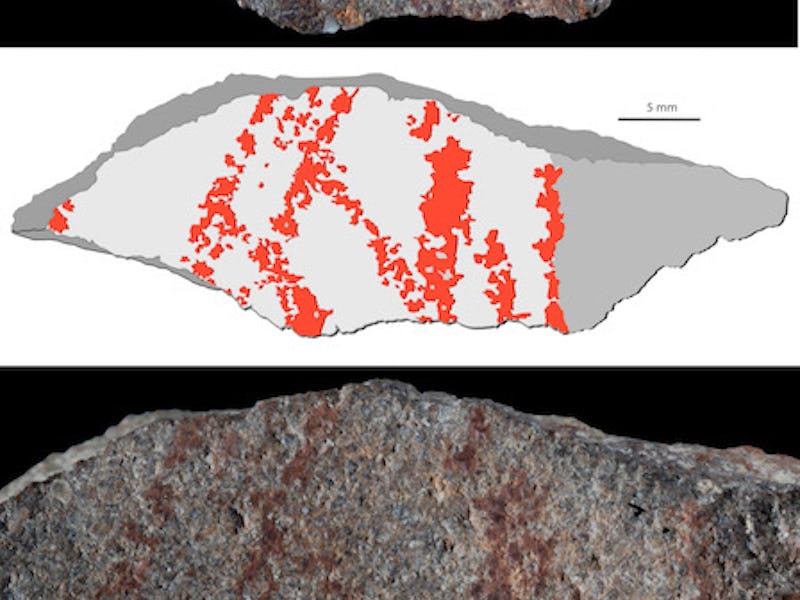Red Cross-Hatched Lines Determined to Be Humankind's Oldest Drawing
The ability to make art is what makes us human.

On Wednesday, scientists announced further proof that creativity and symbolic thought emerged in Africa, further debunking conventional belief that that Homo sapiens didn’t express creativity and symbolic thought until they emigrated to Europe from Africa.
And the proof is something special — the oldest drawing confirmed to be created by humans.
Illustrated on a flake of silcrete rock, the drawing — labeled L13 — consists of nine lines merging in a cross-hatched pattern. Six lines drag diagonally, while three are slightly curved. Their abrupt termination at the stone’s fragmented edges suggests that the flake was a part of a much larger, and more complex, piece of art. According to a team of scientists writing about the discovery in Nature, the drawing is 73,0000-years old, making it 30,000 years older than previously known abstract and figurative drawings.
“The discovery is extraordinary because the chances to recover a drawing are much lower than those of recovering an engraving,” study co-author and University of Bordeaux research director Francesco d’Errico tells Inverse. “I find it incredible that it has survived.”
The drawing and its analysis.
The artifact was excavated in 2011 from the Blombos Cave, a famous archeological site about 186 miles from Cape Town, South Africa. Since 1991 archeologists have unearthed a treasure trove of early human findings in the cave, including a 100,000-year old paint kit and ornamental marine shell beads. When this flake was discovered it gained recognition as unusually ancient art — but it wasn’t confirmed that the lines sketched across the fragment were made intentionally. That distinction needed to be made before it could actually be called art.
The intentional use of symbolism was the focus of the new study, written in part by some of the team members who had originally discovered the piece. The team already knew the drawing’s age through their analysis of rocks and other artifacts in the layer of dirt where the drawing was found. They also suspected it was made by a human because of human teeth found in the cave. To determine whether or not it was purposefully made, however, the team needed to uncover the source of its red lines: an ochre crayon.
Microscopic and chemical analysis of the pattern confirmed that ancient humans used ochre, a natural red clay pigment, to create the cross-hatched pattern. The team then tried to recreate similar ochre drawings themselves, etching layers of ochre with a point or an edge and then diluting what they created. When they compared their drawings to the ancient original, they observed evidence that the archaic picture was intentionally drawn with a pointed ochre on a surface that was smoothed by rubbing before the artist set to work.
“When you study the lines under a microscope, you can still see the same features produced by drawing the lines experimentally with an ochre crayon,” D’Errico notes.
The oldest known engraving in human history.
This finding confirms that the drawing is an intentional expression of symbolic thought much like the oldest known engraving — a zigzag pattern carved into a 500,000-year old freshwater muscle — or the 35,000-year old cave paintings recently identified as Neanderthal art. D’Errico explains that the cross-hatch is believed to be a symbol because it was made with intention and because the team has also found engravings in the same archeological layer with the same criss-cross patterns.
“This reinforces the view that the Blombos people were producing the same signs on different media,” D’Errico says. “These signs were probably used as symbols. A meaning was attached to them.”
While symbolism is second-nature to modern humans, the fact that we can represent thoughts and events that aren’t actually present is a unique skill that sets us apart from other animals. Experts believe that creating art means engaging in complex involved planning and when early humans picked up a red clay crayon, they were setting themselves on a path toward modern behavior.